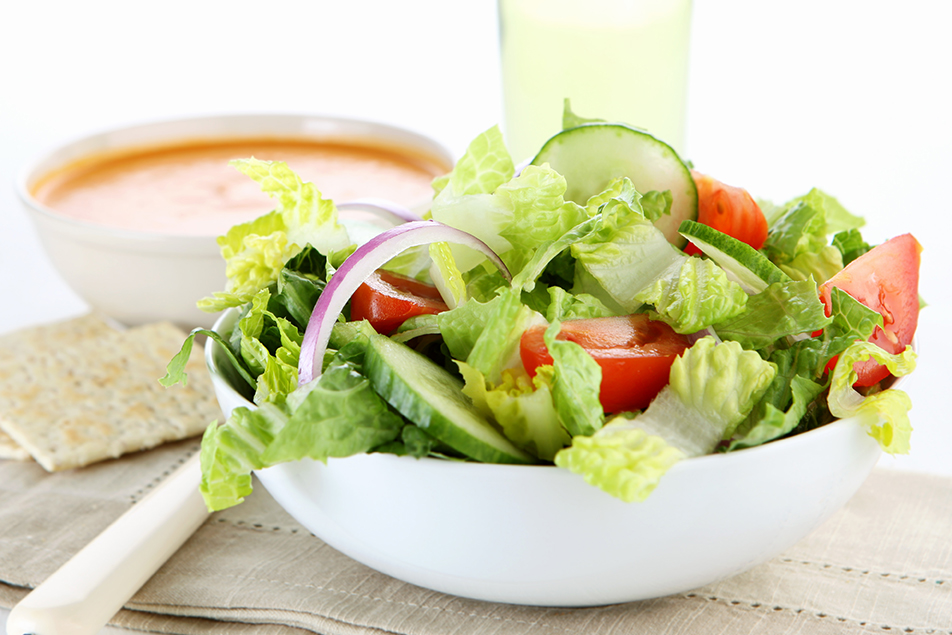
This series was written and created by Sarah Mohrman, RDN, LD, MA, dietitian, program coordinator, PPG – Cardiology.
In Week 3, we built a better breakfast. It’s only fair that we give the same treatment to our midday meal. Lunches tend to be the easiest meal to switch over, as we often eat at work or home by ourselves.
Sandwich swaps
An easy upgrade is recreating your cold meat sandwich with the veggies you have on hand. Go plant-forward by starting with whole grain bread or a tortilla, then use hummus for a spread instead of mayo, and pile the plants high. I like spinach, tomato, onion, roasted red peppers and shredded carrots, but anything goes!
Satisfying salads
Trying to watch your carbs? Fill up a salad bowl with dark, leafy greens, tomatoes, peppers, onions, carrots, mushrooms, broccoli, edamame, chickpeas, dried cranberries and pecans. This will surely be a filling salad, high in antioxidants and phytochemicals. Use a vinegar-based dressing on top of your salad and enjoy!
Keep basic ingredients for salads in your crisper drawer and salad toppings in your pantry. Try this to construct your next colorful salad:
- Build your base – The darker the lettuce, the more nutrition it has packed in the leaves. Opt for spinach, kale, spring mix, radicchio or romaine.
- Nutrient boost – Adding extra fruits or vegetables to a salad helps by, not only introducing more textures, but also boosting the nutrients. Consider adding foods like chopped cauliflower or broccoli, matchstick carrots, mushrooms, snow peas, radishes, peppers, beets, chopped apples, fresh berries, grapes or dried cherries.
- Put in some protein – Top your salad with black beans, quinoa, pumpkin seeds, pistachios, chickpeas, edamame, tofu, pecans, walnuts or sunflower seeds.
- Dress it up – Look for an oil- or vinegar-based dressing or salsa to heighten the flavor and bring it all together.
- Small additions equal big flavor – Lastly, garnishing with fresh herbs such as cilantro, parsley or basil, or even chopped green onions can really increase the flavor. Diced avocado is another delicious addition.
Soups + Recipe to try
Another great strategy, especially during the winter months, is to make a plant-based soup or chili and plan for leftovers to use for lunches during the week. Any plant-forward soup will do, but I love this vegetable soup on a chilly afternoon.
Vegetable Soup
7 cups unsalted vegetable broth or stock
1½ cups chopped yellow onion (1 medium)
2 cups peeled and chopped carrots (about 4)
1¼ cups chopped celery (about 3)
4 cloves garlic, minced
2 14.5-ounce cans diced tomatoes (undrained)
3 cups peeled, ½-inch thick diced potatoes (about 3 medium)
? cup chopped fresh parsley 2 bay leaves
½ teaspoon dried thyme
Salt and freshly ground black pepper, to taste
1½ cups chopped frozen or fresh green beans
1¼ cups frozen or fresh corn
1 cup frozen or fresh peas
1. Heat 2 tablespoons vegetable broth in bottom of stock pot.
2. Add onions, carrots and celery, and sauté 4 minutes then add garlic and sauté 30 seconds longer.
3. Add in the rest of the broth, tomatoes, potatoes, parsley, bay leaves and thyme, and season with salt and pepper, to taste (for more flavor add in more dried herbs, as desired).
4. Bring to a boil, then add green beans.
5. Reduce heat to medium-low, cover and simmer until potatoes are tender, about 20–30 minutes, then add corn and peas and cook 5 minutes longer. Serve warm.
Serves 8
Nutrition Facts (per serving): 240 calories, 0mg cholesterol, 1g total fat, 50g carbohydrate, 0g saturated fat, 7.75g fiber, 236mg sodium, 6.5g protein
Adapted from a recipe featured on Cooking Classy™.
For more recipes, tips and inspiration on living a heart-healthier lifestyle, like Her Heart on Facebook.
